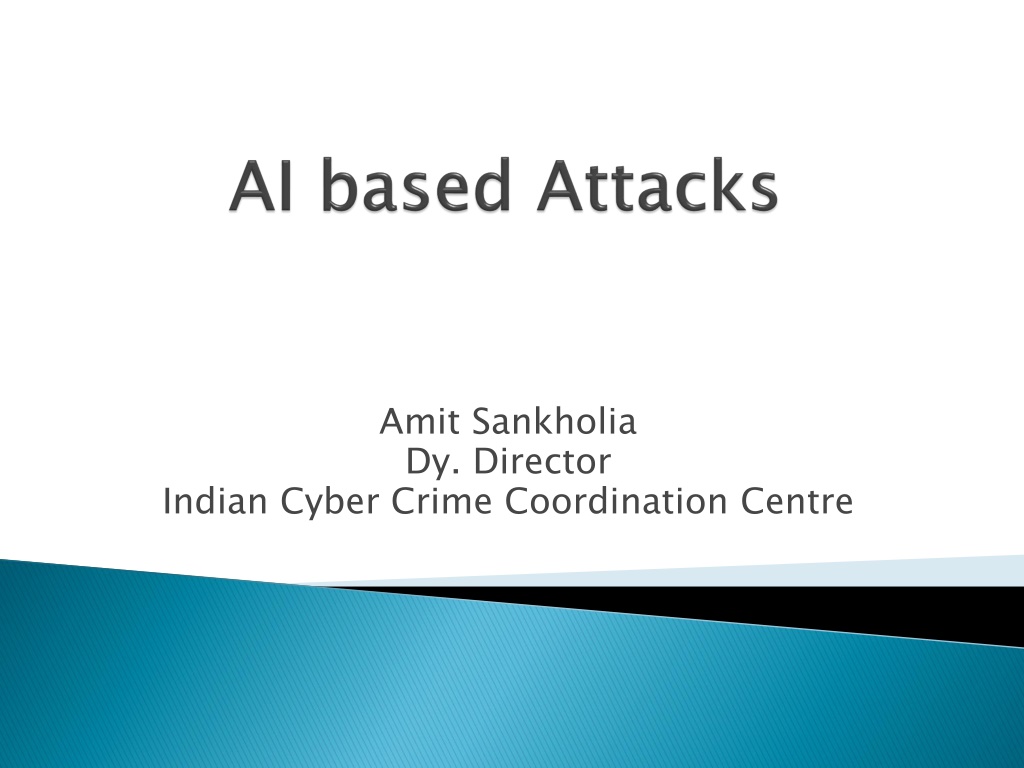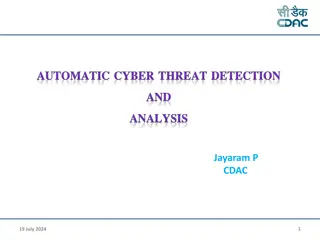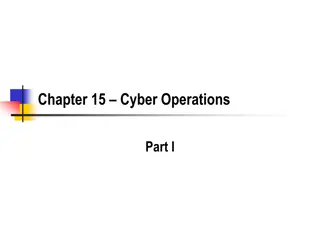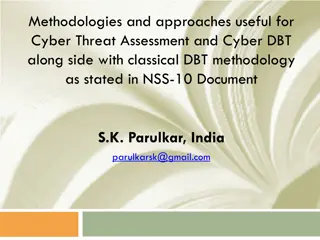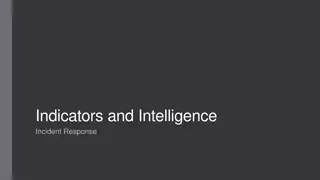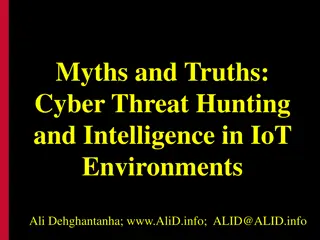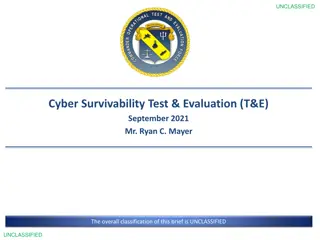Artificial Intelligence in Cyber Security: Enhancing Threat Detection and Response
Artificial Intelligence (AI) is revolutionizing cyber security by enhancing threat detection, response, and prevention capabilities. By leveraging machine learning algorithms, AI enables organizations to identify cyber threats, analyze behavioral patterns, automate incident response, adapt to evolving threats, and enhance user authentication methods. The integration of AI in cyber security marks a dynamic shift in how organizations defend against cyber threats, empowering proactive measures to detect and mitigate risks efficiently.
Download Presentation

Please find below an Image/Link to download the presentation.
The content on the website is provided AS IS for your information and personal use only. It may not be sold, licensed, or shared on other websites without obtaining consent from the author. Download presentation by click this link. If you encounter any issues during the download, it is possible that the publisher has removed the file from their server.
E N D
Presentation Transcript
Amit Sankholia Dy. Director Indian Cyber Crime Coordination Centre
Introduction to Artificial Intelligence Understanding AI in Cyber-security Evolution of Cyber Threats Types of AI based attacks Adversarial ML Deep fake Attacks AI powered malwares Detection Challenges Future Trends 1. 2. 3. 4. 5. 6. 7. 8. 9. 10. Conclusion 11. Q&A
Artificial Intelligence perform tasks that typically require human intelligence. These tasks include learning, reasoning, problem-solving, understanding natural language, and perception. Artificial Intelligence (AI) refers to the development of computer systems that can Learning and Adaptation analyze data, identify patterns, and make decisions. They can adapt and improve their performance over time without explicit programming, learning from experience. Learning and Adaptation: AI systems employ machine learning algorithms to Applications image processing to autonomous vehicles and strategic game playing. It encompasses both narrow AI, designed for specific tasks, and general AI, aiming to replicate human cognitive abilities across a broad range of activities. Applications: AI finds diverse applications, ranging from speech recognition and
The integration of AI in cyber security represents a dynamic shift in how organizations defend against evolving threats. AI is employed to enhance detection, response, and prevention capabilities: Threat Detection identify patterns indicative of cyber threats. Machine learning models can detect anomalies, helping to identify previously unknown threats. Behavioral Analysis behavior, allowing for the identification of deviations from normal patterns. This proactive approach enhances the ability to spot potential threats before they escalate. Threat Detection: AI algorithms analyze vast amounts of data to 1. 1. Behavioral Analysis: AI enables the monitoring of user and system 2. 2.
3. Automation and Response response by quickly analyzing and categorizing security incidents. Automated responses can be triggered for immediate mitigation, reducing the response time to cyber threats. 4. Adaptive Security Measures data, adapting to emerging threats and evolving attack techniques. This adaptability is crucial in addressing the dynamic nature of cybersecurity threats. 5. User Authentication implementing multi-factor authentication and biometric recognition, reducing the risk of unauthorized access. Automation and Response: AI-driven automation streamlines incident . Adaptive Security Measures: AI systems continuously learn from new User Authentication: AI plays a role in enhancing user authentication by
6. Malware Detection identifying sophisticated malware by analyzing code patterns and behaviors. This capability improves the identification of malicious software, including those leveraging AI themselves. 7. Predictive Analysis forecasting potential threats based on historical data and current trends. This helps organizations proactively strengthen their defenses against future cyber attacks. Malware Detection: AI-powered systems excel in Predictive Analysis: AI enables predictive analysis,
Increasing Sophistication attacks to highly sophisticated and nuanced strategies. Attackers now employ advanced techniques making it challenging for traditional security measures to keep up. Increasing Sophistication: Cyber threats have evolved from simple, easily detectable Diversification of Targets individual users to encompass large enterprises, critical infrastructure, and even entire nations. This diversification poses significant risks as cybercriminals seek financial gain, political motives, or simply to create widespread disruption. Diversification of Targets: The range of targets for cyber threats has expanded beyond Global Interconnectedness interconnectedness of the global digital landscape. The internet's expansion and the increasing reliance on interconnected devices have created a broader attack surface, allowing cyber threats to propagate rapidly and impact diverse sectors across the globe. Global Interconnectedness: The evolution of cyber threats is closely tied to the growing
Adversarial Machine Learning Deep fake Attacks AI-Powered Malware
Purposeful Manipulation manipulating input data to deceive machine learning models. By making subtle alterations to input features, adversaries aim to exploit vulnerabilities and cause the model to misclassify or make incorrect predictions. Purposeful Manipulation: Adversarial machine learning involves attackers purposefully Evasion and Misclassification causing misclassification. Attackers use techniques like adding imperceptible noise to images or tweaking input values to trick machine learning algorithms into producing inaccurate results, compromising the reliability of the model. Evasion and Misclassification: Adversarial attacks often focus on evading detection or Continuous Cat adversarial attacks, adversaries adapt their methods, leading to a continuous cat-and- mouse game between attackers and defenders. This dynamic challenges the development of robust machine learning models that can withstand evolving adversarial strategies. Continuous Cat- -and and- -Mouse Game Mouse Game: As machine learning models improve in detecting
Deepfake attacks pose a substantial threat to individuals and organizations by leveraging advanced AI to create convincingly realistic manipulated content. These maliciously crafted videos or audio recordings can damage reputations, spread misinformation, and incite mistrust. Individuals may face personal harm as their identities are exploited, while organizations risk brand damage, financial losses, and the erosion of public trust. The potential for deepfakes to deceive and manipulate poses significant challenges for cybersecurity and underscores the critical need for advanced detection and mitigation measures to protect against the multifaceted impacts of these deceptive AI-driven attacks.
AI-driven malware represents a paradigm shift in cyber threats. Infused with artificial intelligence capabilities, this malware adapts, learns, and evolves, making it highly sophisticated and difficult to detect. Its autonomous nature allows for dynamic, targeted attacks, posing a significant challenge to traditional cybersecurity measures, necessitating advanced defense strategies.
Detecting AI-based attacks presents challenges due to their adaptive nature. These attacks dynamically evolve, leveraging machine learning to mimic normal behavior and evade traditional detection methods. The use of adversarial techniques, where attackers manipulate input data to confuse models, adds complexity. As AI becomes integral to cybersecurity, distinguishing between legitimate AI activities and malicious intent becomes intricate. The rapid evolution of attack strategies demands continuous updates in detection mechanisms. Addressing these difficulties requires a multifaceted approach, combining advanced algorithms, continuous monitoring, and a thorough understanding of AI's dual role in defending against and facilitating cyber threats.
Anticipating the evolution of AI-based attacks demands foresight into emerging technologies and potential adversarial strategies. As AI capabilities advance, attackers are likely to exploit novel techniques, including more sophisticated adversarial machine learning and the synthesis of hyper-realistic deepfakes. The integration of AI in cybersecurity tools necessitates a proactive stance, predicting how attackers might leverage these advancements. Constant research and collaboration between cybersecurity experts are essential to stay ahead, developing robust defenses and adaptive strategies. Vigilance in monitoring emerging trends and understanding the evolving threat landscape are crucial elements in anticipating and mitigating the future evolution of AI-based cyber attacks
Invest in Advanced Threat Detection deployment of advanced threat detection systems that leverage AI for anomaly detection and behavior analysis. These systems can identify subtle patterns indicative of AI-based attacks, enhancing the ability to detect and respond to evolving cyber threats. Invest in Advanced Threat Detection: Organizations should prioritize the Continuous Employee Training vulnerabilities through tactics like phishing, continuous employee training is crucial. Educating staff on recognizing and reporting suspicious activities, particularly those involving AI-driven manipulation, helps fortify the human element of cybersecurity. Continuous Employee Training: As AI-based attacks often exploit human Implement Adaptive Security Measures evolve in response to emerging threats. Regularly update and upgrade cybersecurity protocols, leveraging AI-driven solutions that learn from new data and adjust defenses accordingly. This dynamic approach is essential for staying resilient against the ever-evolving tactics of AI-powered adversaries. Implement Adaptive Security Measures: Employ adaptive security measures that
1. Which of the following is an example of an AI-based cyberattack? a) Phishing b) Ransomware c) Adversarial Machine Learning d) DDoS attacks
2. What is the primary purpose of deepfake technology in the context of cybersecurity? a) Data encryption b) User authentication c) Identity deception d) Network intrusion
3. AI-powered malware is characterized by: a) Static behavior b) Limited sophistication c) Dynamic adaptation d) Slow propagation
4. How do AI-driven attacks challenge traditional threat detection methods? a) By reducing false positives b) By relying on signature-based detection c) By prioritizing known attack vectors d) By constantly evolving and adapting
5. In adversarial machine learning attacks, what is the main goal of the attacker? a) Data encryption b) Manipulating machine learning models c) Launching DDoS attacks d) Spreading malware
6. What is a key difficulty in detecting adversarial machine learning attacks? a) Lack of skilled cybersecurity professionals b) Overreliance on AI algorithms c) Limited computing resources d) Difficulty in distinguishing malicious from normal data
7. Why is continuous monitoring crucial in defending against AI-based cyber threats? a) To prevent malware infections b) To identify patterns and anomalies over time c) To update antivirus signatures d) To enhance network speed
8. Which of the following is a real-world example of AI impacting a cyber attack? a) Heartbleed vulnerability b) Stuxnet worm c) WannaCry ransomware d) None of above
9. How does AI enhance the sophistication of modern cyber threats? a) By simplifying attack techniques b) By relying on outdated algorithms c) By automating and adapting attack strategies d) By reducing attack surface
c) Adversarial Machine Learning c) Identity deception c) Dynamic adaptation d) By constantly evolving and adapting b) Manipulating machine learning models d) Difficulty in distinguishing malicious from normal data b) To identify patterns and anomalies over time d) None of above c) By automating and adapting attack strategies 1. 2. 3. 4. 5. 6. 7. 8. 9.
